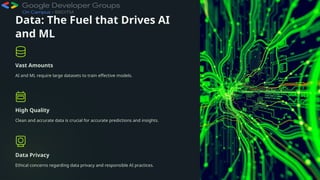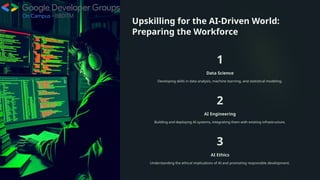Artificial Intelligence and Machine Learning and Python FINAL.pptx
- 1. Artificial Intelligence and Machine Learning: Powering the Future Welcome to this presentation exploring the exciting world of artificial intelligence and machine learning. We'll dive into their definitions, evolution, applications, and the transformative impact they have on our world.
- 2. Introduction to AI and ML: Demystifying the Buzzwords Artificial Intelligence (AI) The ability of a computer or machine to mimic human intelligence, including learning, problem-solving, and decision-making. Machine Learning (ML) A subset of AI where machines learn from data without explicit programming, improving their performance over time.
- 3. The Evolution of AI: From Narrow to General Intelligence 1 Early AI: Focused on specific tasks like playing chess or recognizing patterns. 2 Modern AI: Expanding capabilities, including natural language processing, image recognition, and self- driving cars. 3 Future AI: Aiming for general intelligence, where machines can perform any intellectual task a human can.
- 4. Machine Learning Algorithms: Supervised, Unsupervised, and Reinforcement Supervised Learning Trains algorithms on labeled data to make predictions based on new, unseen data. Unsupervised Learning Discovers patterns and insights from unlabeled data, revealing hidden structures and relationships. Reinforcement Learning Trains algorithms through trial and error, learning from rewards and punishments to achieve optimal actions.
- 5. Data: The Fuel that Drives AI and ML Vast Amounts AI and ML require large datasets to train effective models. High Quality Clean and accurate data is crucial for accurate predictions and insights. Data Privacy Ethical concerns regarding data privacy and responsible AI practices.
- 6. AI in Action: Real-World Applications and Use Cases Healthcare AI aids in diagnosing diseases, developing new treatments, and personalizing patient care. Finance AI detects fraud, analyzes market trends, and provides personalized financial advice. E-commerce AI powers personalized recommendations, improves search results, and automates customer service.
- 7. Ethical Considerations: Addressing Bias and Transparency 1 Fairness Ensuring AI algorithms are unbiased and treat everyone fairly. 2 Transparency Making AI systems understandable and accountable for their decisions. 3 Privacy Protecting user data and privacy in AI applications.
- 8. The Future of AI and ML: Trends and Predictions 1 AI-Powered Automation Automation of tasks across industries, impacting employment and productivity. 2 AI-Driven Innovation Advancements in AI research leading to groundbreaking discoveries and inventions. 3 Ethical AI Growing emphasis on ethical AI development and responsible use.
- 9. Upskilling for the AI-Driven World: Preparing the Workforce 1 Data Science Developing skills in data analysis, machine learning, and statistical modeling. 2 AI Engineering Building and deploying AI systems, integrating them with existing infrastructure. 3 AI Ethics Understanding the ethical implications of AI and promoting responsible development.
- 10. Python: The Language of Artificial Intelligence and Machine Learning Python is a versatile programming language widely used in artificial intelligence (AI) and machine learning (ML). It's known for its readability, ease of use, and extensive libraries, making it a powerful tool for building complex AI systems.
- 11. Introduction to Python Simple Syntax Python's clear syntax allows for easy reading and writing, reducing the learning curve for new programmers. Interpreted Language Python executes code line by line, simplifying debugging and allowing for rapid prototyping.
- 12. Key Features of Python 1 Object-Oriented Programming Python supports OOP principles, allowing for modular and reusable code. 2 Dynamic Typing Python automatically infers data types, eliminating the need for explicit type declarations. 3 Extensive Libraries Python boasts a wealth of pre- built libraries, providing ready- to-use solutions for various tasks.
- 13. Python's Role in AIML 1 Data Analysis Python's powerful data manipulation libraries are essential for analyzing and preparing large datasets. 2 Model Building Python libraries like scikit-learn and TensorFlow provide tools for building and training sophisticated AI models. 3 Model Deployment Python frameworks facilitate deploying AI models into real-world applications.
- 14. Python Libraries for AIML NumPy NumPy is a fundamental library for numerical computing, providing powerful array manipulation and mathematical functions. Pandas Pandas is a data manipulation library that enables efficient data cleaning, transformation, and analysis. Scikit-learn Scikit-learn is a versatile machine learning library offering algorithms for classification, regression, clustering, and more. TensorFlow TensorFlow is a popular deep learning library designed for building and training complex neural networks.
- 15. Python for Data Preprocessing Data Cleaning Python libraries help remove inconsistencies, handle missing values, and ensure data quality. Data Transformation Python allows scaling, normalization, and encoding to prepare data for model training. Feature Engineering Python enables creating new features from existing data, improving model performance.
- 16. Python for Model Building 1 Model Selection Python offers a wide range of algorithms to choose from, depending on the problem and data. 2 Model Training Python libraries provide functions for training models using labeled data, optimizing for accuracy. 3 Model Evaluation Python allows evaluating model performance using metrics such as accuracy, precision, and recall.
- 17. Python for Model Deployment Cloud Platforms Deploy models to cloud services like AWS and GCP for scalability and accessibility. Web Applications Integrate models into web applications to provide AI-powered functionalities. Mobile Apps Deploy models on mobile devices to provide personalized experiences.
- 18. Python for Evaluation and Monitoring 1 Performance Metrics Track key metrics to assess model performance and identify potential issues. 2 Data Drift Monitor data changes over time and retrain models as needed to maintain accuracy. 3 Model Bias Identify and address potential biases in the model to ensure fairness and ethical use.
- 19. Challenges and Best Practices Python's vast ecosystem presents challenges for beginners. Focusing on fundamental concepts and practicing regularly is key. Leveraging best practices and community resources can streamline development and ensure ethical AI development.
- 20. Conclusion: The Transformative Potential of AI and ML AI and ML are transformative technologies with the power to shape our future. By understanding their principles, applications, and ethical considerations, we can harness their potential to solve complex challenges and create a more innovative and prosperous world.



















